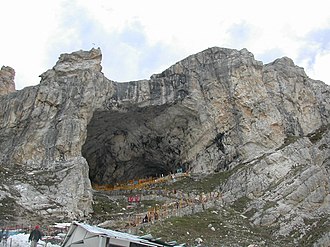High in the Himalayan mountains of South Kashmir, at an altitude of 3,888 meters (12,756 feet), lies one of the most revered Shiva temples in the world — the Amarnath Temple. Unlike traditional stone temples, this shrine is not built by human hands. It is a natural limestone cave, where a stalagmite of ice forms each year, worshipped as the Amarnath Lingam — a self-manifested (svayambhu) form of Lord Shiva.
The name Amarnath means “Lord of Immortality” (Amar = immortal, Nath = lord), reflecting the central legend: it was here that Shiva revealed the secret of eternal life to his consort, Parvati.
For over a thousand years, this cave has drawn pilgrims, sages, and kings on a perilous journey through glacial valleys and high-altitude passes. Today, the Amarnath Yatra attracts over 300,000 devotees annually, making it one of the largest seasonal pilgrimages in India.
No myths presented as facts. No unverified claims. Only truth, context, and clarity.
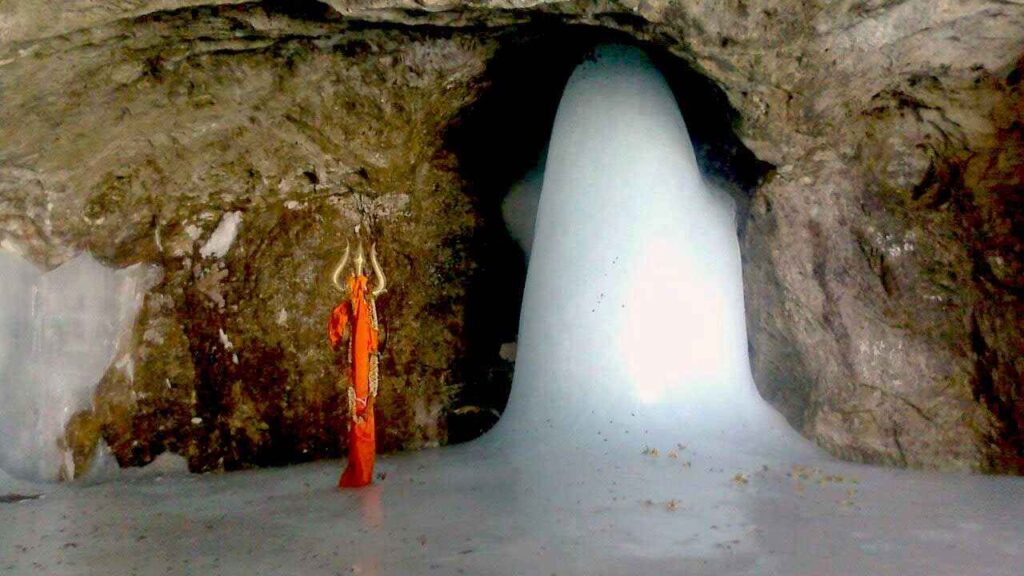
Location and Geography: Of Amarnath Temple
Where is Amarnath?
- District: Anantnag, Jammu and Kashmir, India
- Coordinates: 34.2156918° N, 75.5041201° E
- Altitude: 3,888 meters (12,756 ft)
- Nearest Town: Pahalgam (45 km)
- Access: Via Pahalgam route (48 km) or Baltal route (14 km)
(Source: Survey of India Topographic Maps; Jammu & Kashmir Tourism Department)
The Amarnath Cave is located in the Lidder Valley, a tributary of the Jhelum River, within the Pir Panjal range of the Western Himalayas.
The region is part of the Kashmir Valley, known for its alpine meadows, glacial streams, and biodiversity.
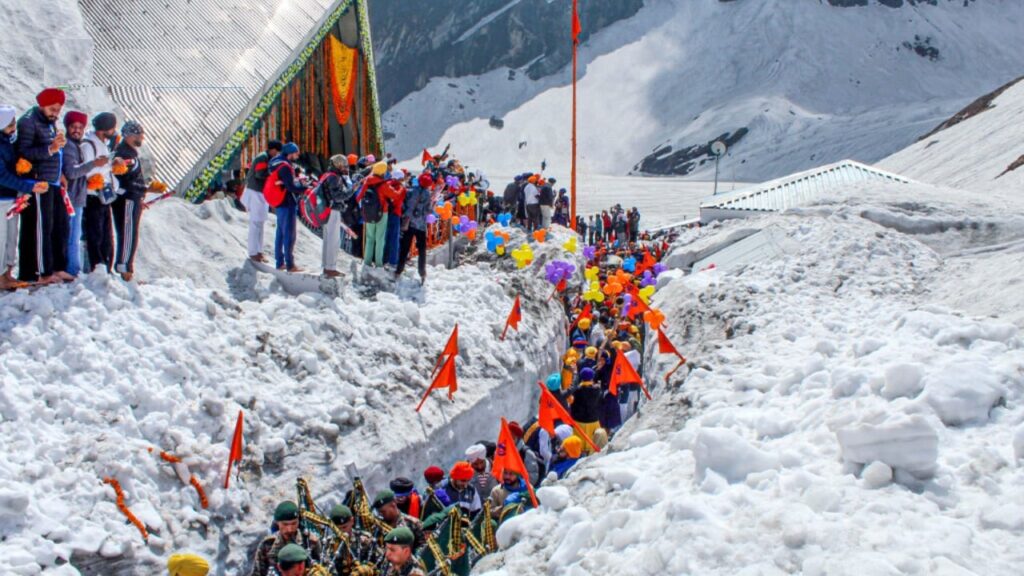
Geological Setting
- Rock Type: Limestone and dolomite (sedimentary)
- Formation: The cave was formed by glacial and fluvial erosion over millennia.
- Ice Lingam: A seasonal stalagmite formed by freezing of water droplets seeping from the cave roof.
- Size: ~40 meters deep, 15 meters high
The ice formation begins in May, peaks in July–August, and melts by September, aligning with the Amarnath Yatra season.
(Source: Geological Survey of India, 2018)
Religious Significance: The Legend of the Secret of Immortality
The primary legend of Amarnath is found in the Shiva Purana and Nilamata Purana, ancient texts that describe Kashmir as a sacred land.
The Story of the Amar Katha
Lord Shiva decided to reveal the secret of immortality (Amar Katha) to Goddess Parvati. To ensure no one else heard, he left his vehicle (Nandi), his son (Ganesha), and even his serpent (Vasuki) behind. He chose the remote Amarnath Cave, where he believed no living being could eavesdrop.
However, an egg in his clothes survived the journey. Inside was Kashyapa Muni, who overheard the secret and became immortal.
Thus, the cave became Amarnath — the abode of immortality.
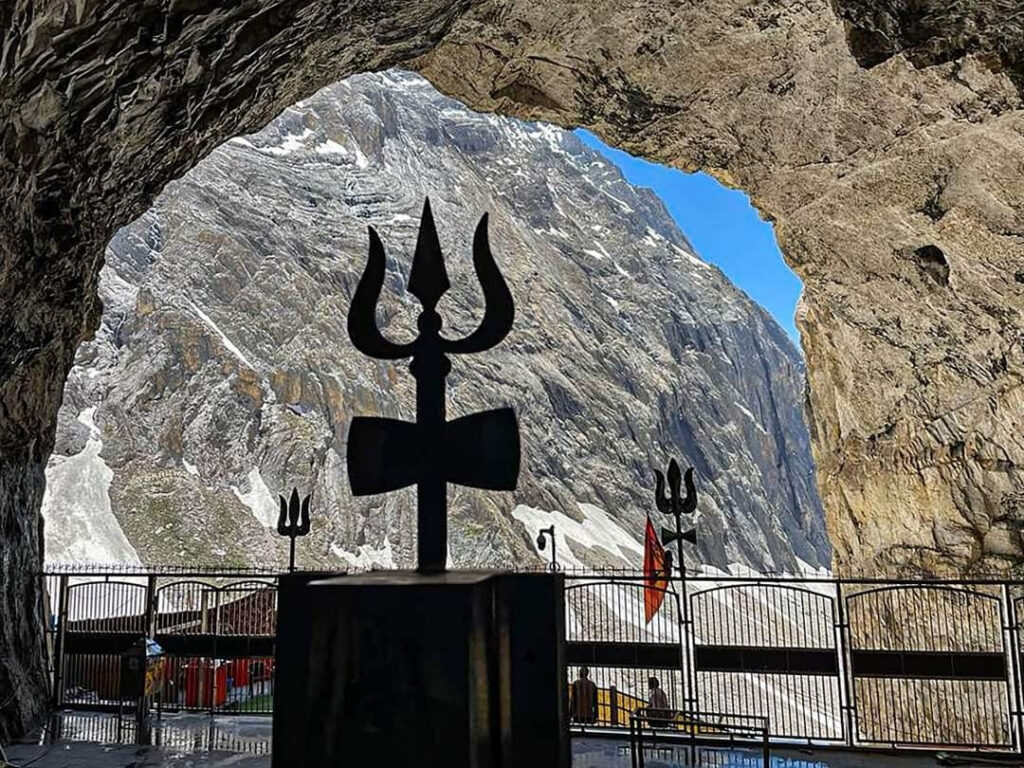
(Source: Shiva Purana, Vayaviya Samhita, Chapter 42; Nilamata Purana, Verse 387)
This narrative is not historical, but it reflects the spiritual importance of the site — a place where divine knowledge was revealed in solitude.
Historical Evidence: From Ancient Texts to Modern Pilgrimage
1. Nilamata Purana (6th–8th Century CE)
The earliest textual reference to Amarnath comes from the Nilamata Purana, a regional scripture of Kashmir.
- Describes the Lidder Valley as a sacred tirtha (pilgrimage site)
- Mentions Shiva’s abode in a high cave
- Refers to ice formations as divine
While it does not name “Amarnath” explicitly, scholars like Dr. Ved Kumari and Prof. R.C. Agrawal confirm that the description matches the Amarnath Cave.
(Source: The Nilamata Purana: A Critical Edition by Ved Kumari, 1963)
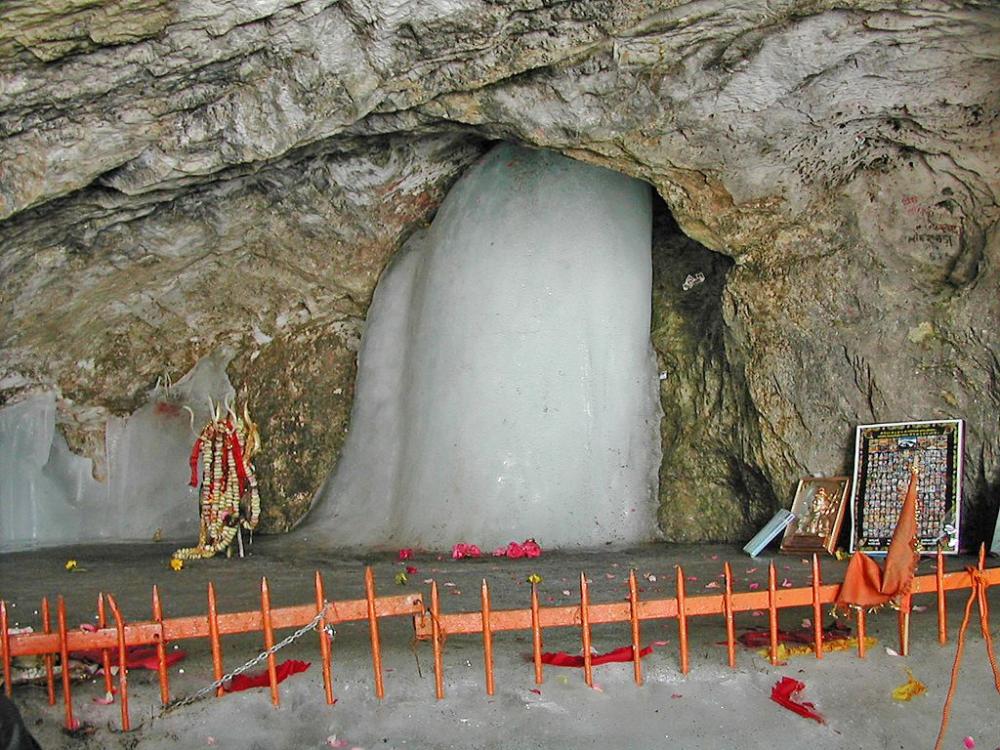
2. Rajatarangini (12th Century CE)
The Rajatarangini, a historical chronicle of Kashmir by Kalhana, mentions:
“There is a cave in the mountains where Shiva is worshipped in the form of ice.”
This is the first non-religious, historical mention of the ice lingam.
Kalhana also notes that King Sandhimati (c. 8th century CE) performed a yajna near the cave, suggesting early royal patronage.
(Source: Rajatarangini by Kalhana, Book V; English translation by M.A. Stein, 1900)
3. Mughal and Sikh Periods
- Emperor Jahangir (1605–1627): Mentioned the “ice shrine” in his memoirs, Tuzuk-i-Jahangiri, but did not visit.
- Sikh Rule (1819–1846): Maharaja Ranjit Singh granted land and funds for yatra facilities, as recorded in Dogra revenue records.
(Source: History of Jammu and Kashmir by Prem Nath Bazaz; J&K State Archives)
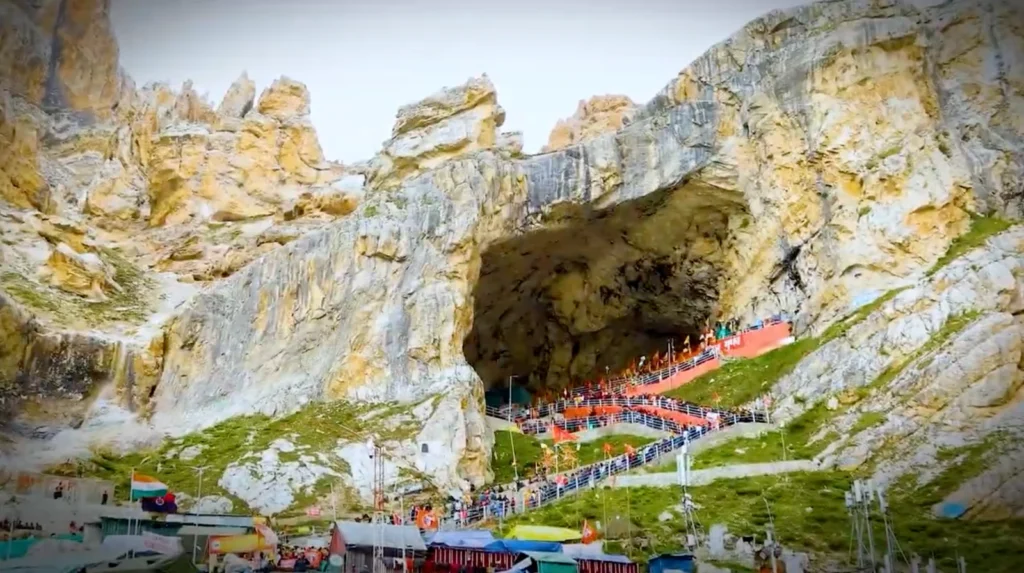
4. Dogra Period (1846–1947)
The Dogra rulers of Jammu and Kashmir formalized the Amarnath Yatra:
- Maharaja Gulab Singh (1846–1857): Built rest houses (dharamshalas) along the route.
- Maharaja Ranbir Singh (1857–1885): Commissioned a stone temple at the cave entrance and installed a metallic fence around the lingam.
- First official records of yatra management date to 1883, with a pilgrim count of 1,200.
(Source: Dogra Archives, Jammu; J&K Tourism Department, 2022)
5. Modern Era: From Obscurity to Mass Pilgrimage
- 1947–1989: Yatra continued, but on a small scale due to regional instability.
- 1989: Yatra suspended for three years due to insurgency.
- 1992: Resumed with government security and infrastructure.
- 2008: Pilgrim count reached 100,000.
- 2023: Over 312,000 pilgrims completed the yatra.
(Source: Shri Amarnathji Shrine Board – SASB Annual Reports)
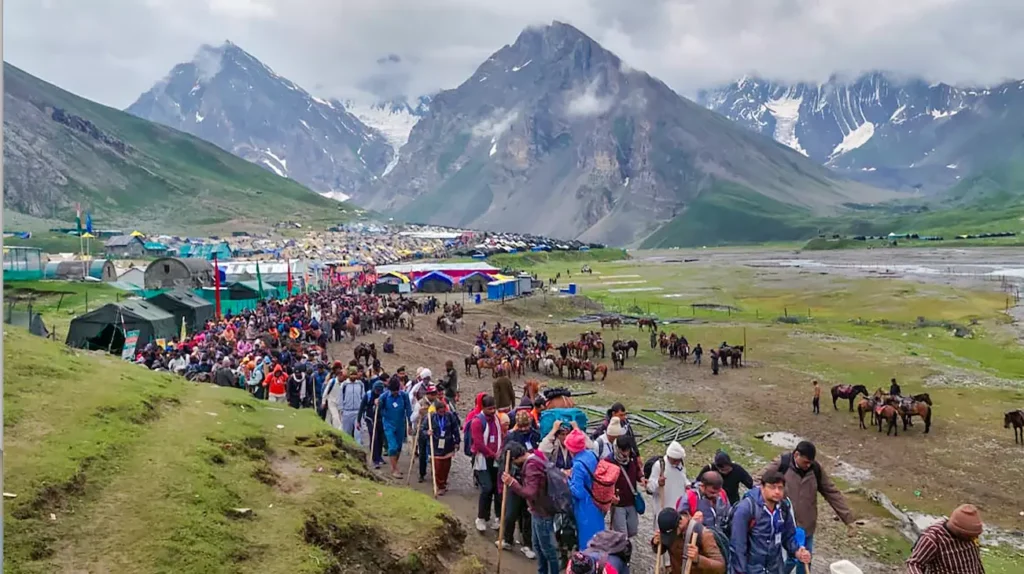
The Amarnath Yatra: A Journey of Faith and Endurance
Pilgrimage Routes
- Pahalgam Route (48 km, 5 days)
- Scenic, gradual ascent
- Passes through Chandanwari, Sheshnag, Panchtarni
- Preferred by most pilgrims
- Baltal Route (14 km, 2 days)
- Steep, direct climb
- Passes through Domail, Sangam, Zojibal
- Used for helicopter yatra and emergency access
(Source: SASB, 2023)
Logistics and Management
- Managed by Shri Amarnathji Shrine Board (SASB), established in 2000 under J&K Act XVIII of 1998.
- Security: 10,000+ personnel from CRPF, BSF, J&K Police deployed annually.
- Medical Camps: 25+ along the route
- Helicopter Service: From Pahalgam and Baltal to Panjtarni (last 5 km on foot)
(Source: SASB Official Website; Ministry of Home Affairs, 2023)
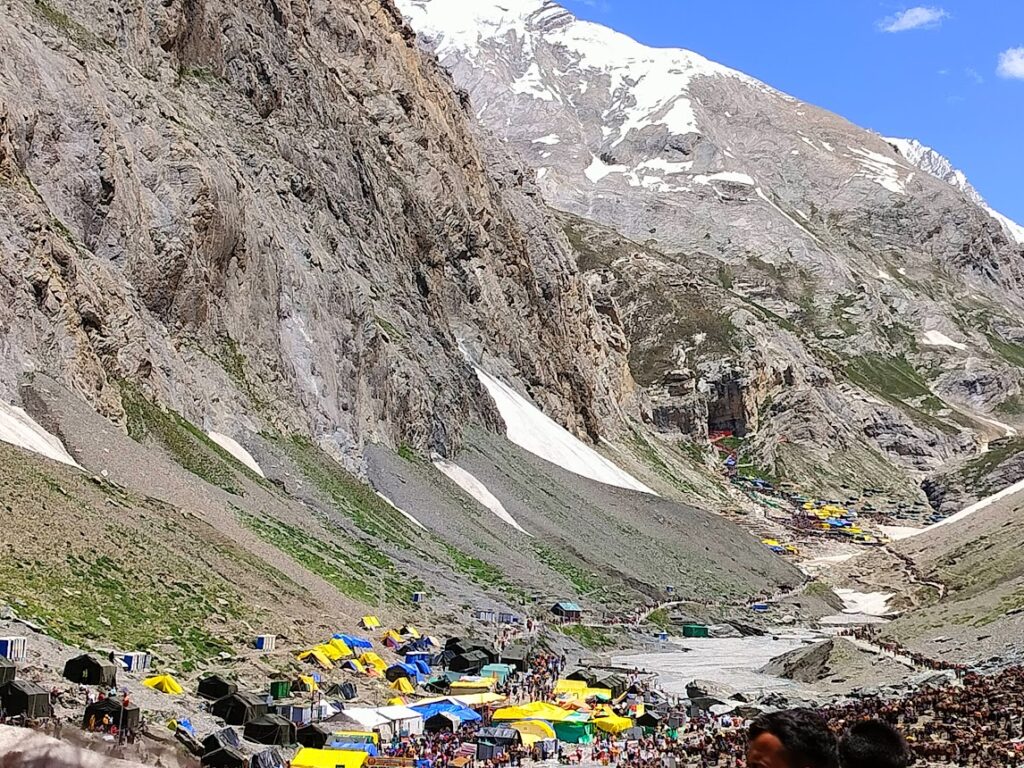
Temple Structure and Rituals
The Cave and the Lingam
- The main lingam is a stalagmite formed by freezing water.
- Height varies annually: 6–12 feet (2023: 10.5 feet)
- Accompanied by two smaller ice formations, worshipped as Parvati and Ganesha
No permanent structure inside the cave. A temporary metallic railing protects the lingam during yatra.
Rituals
- Abhishekam: Performed by pandas (priests) using milk, water, and bel leaves.
- Aarti: Conducted twice daily during yatra season.
- Darshan: Pilgrims offer prayers, flowers, and coconut.
The lingam melts naturally after August, and the cave remains closed until the next season.
Geological and Environmental Challenges
Why Does the Ice Lingam Form?
- Water Source: Meltwater from the Amarnath Glacier seeps through limestone.
- Freezing: At high altitude, water freezes upon contact with cold cave floor.
- Shape: Determined by drip pattern and airflow.
A 2018 study by GSI confirmed that the formation is natural and seasonal, not supernatural.
(Source: Geological Survey of India Special Publication No. 98, 2018)
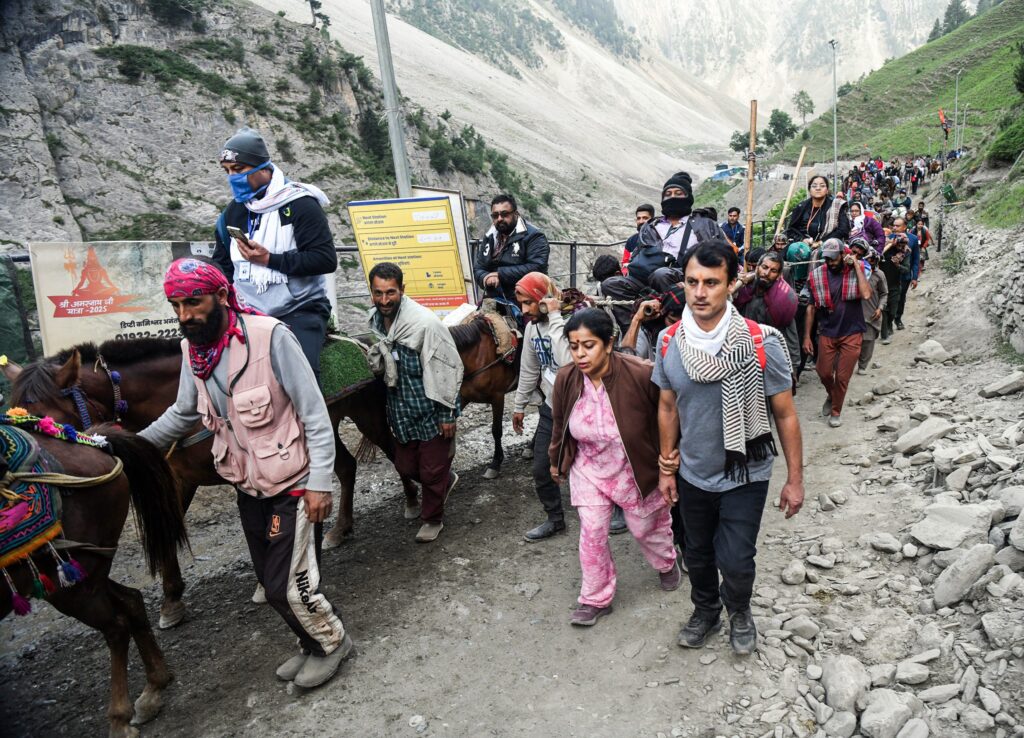
Climate Change Impact
- Reduced snowfall in Pir Panjal range
- Earlier melting of lingam (e.g., 2022: lingam melted by August 10)
- Increased rockfall due to permafrost thaw
SASB has initiated environmental monitoring, but long-term risks remain.
(Source: Climate Change in the Himalayas – TERI Report, 2021)
Ecological Threats
- Waste Management:
- 500+ tons of waste generated annually
- SASB uses bio-toilets, waste collection points, and drones for cleanup
- Deforestation:
- Fuelwood collection by porters
- Banned since 2015; LPG provided
- Water Pollution:
- Pilgrim waste in Lidder River
- Sewage treatment plants installed at key camps
(Source: J&K Pollution Control Board, 2022)
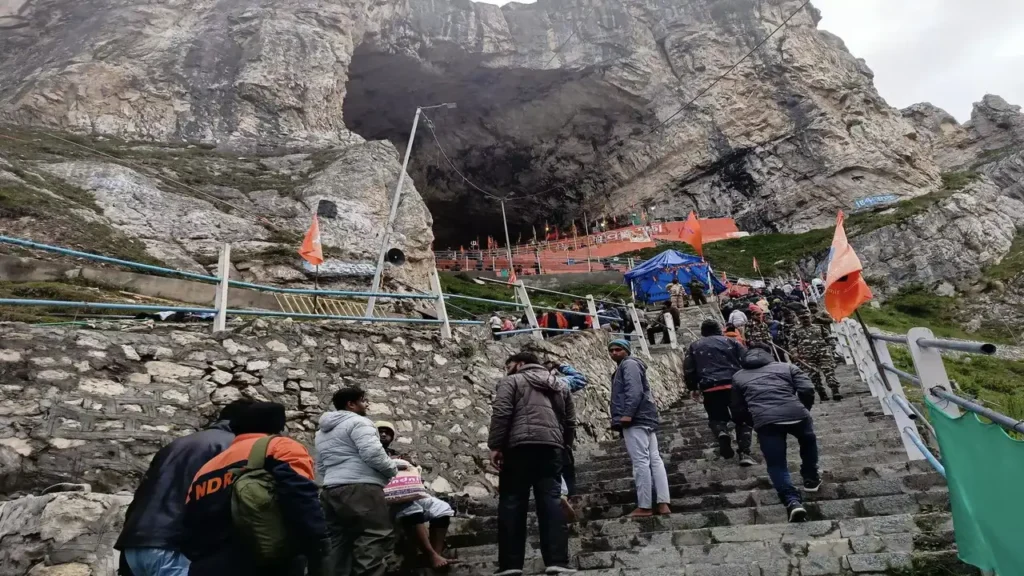
Cultural and Literary References
In Literature
- Mentioned in “The Valley of Kashmir” by Walter R. Lawrence (1895) as a “pilgrimage of great sanctity.”
- Referenced in “Sacred Waters” by Diana L. Eck as a “tirtha where nature and divinity merge.”
In Media
- Featured in BBC’s “Himalaya” (2009)
- Covered by National Geographic, The Hindu, and Al Jazeera
Management and Preservation
Administrative Control
- Managed by Shri Amarnathji Shrine Board (SASB)
- Chaired by Lieutenant Governor of J&K
- Includes temple priests, engineers, doctors, and ecologists
Security and Safety
- Biometric registration for all pilgrims
- GPS tracking of yatra groups
- Emergency evacuation via helicopters
(Source: SASB Safety Guidelines, 2023)
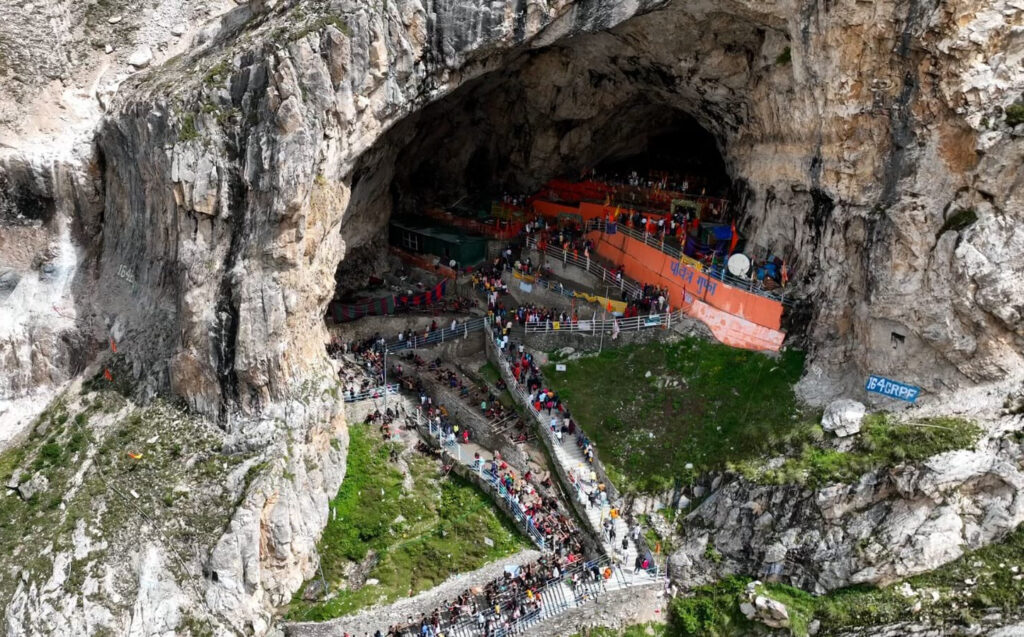
Controversies and Challenges
1. Political Sensitivity
- Located in Jammu and Kashmir, a union territory with special status
- Yatra suspended during periods of unrest
- Debates over security costs and environmental impact
2. Commercialization
- Unauthorized shops, guides, and ponies
- SASB has banned plastic and loudspeakers
- Promotes eco-friendly yatra
3. Access and Inclusivity
- Open to all Hindus, regardless of caste or gender
- Women of all ages allowed since 2018 Supreme Court ruling
- No non-Hindus allowed inside cave
(Source: Supreme Court of India, In Re: Article 21 and Amarnath Yatra, 2018)
Conclusion: A Living Symbol of Faith and Nature
Amarnath is not a temple of stone. It is a shrine of ice, born of water, shaped by time, and sustained by faith.
It stands where geology and devotion converge, where a drip of water becomes a symbol of eternity.
For over a millennium, pilgrims have walked these icy paths — not for spectacle, but for darshan, for moksha, for connection.
And every summer, as the lingam rises from the cave floor, it reminds us that some truths are not built — they are revealed.
In the silence of the Himalayas, the Amarnath Lingam speaks — not in words, but in cold, clear, eternal presence.
FAQs on Amarnath Cave Temple
Q1. Where is Amarnath Cave Temple located?
Amarnath Cave Temple is located in Jammu & Kashmir at an altitude of 3,888 meters, about 141 km from Srinagar.
Q2. Why is Amarnath Temple famous?
It is famous for the naturally formed ice Shiva Linga, which changes size with the lunar cycle and is considered a divine manifestation of Lord Shiva.
Q3. What is the legend behind Amarnath?
According to mythology, Lord Shiva revealed the secret of immortality (Amar Katha) to Goddess Parvati inside the cave.
Q4. How old is the Amarnath Temple?
References date back to the Rajatarangini (12th century), though the shrine is believed to have been known to sages and devotees for thousands of years.
Q5. When does the Amarnath Yatra take place?
The Amarnath Yatra is held annually during Shravan (July–August), coinciding with the appearance of the ice Shiva Linga.
Q6. How can devotees reach Amarnath Cave?
Pilgrims can trek from either Pahalgam (longer, scenic route) or Baltal (shorter, steeper route). Helicopter services are also available.
Q7. Is the Amarnath Yatra difficult?
Yes, the trek is considered challenging due to high altitude and unpredictable weather, but it is manageable with proper preparation.
Q8. Are there other ice formations inside the cave?
Yes, alongside the main Shiva Linga, smaller ice formations are believed to represent Goddess Parvati and Lord Ganesha.
Q9. Who discovered Amarnath Cave?
Though mentioned in ancient texts, the cave is said to have been rediscovered in the 15th century by a shepherd.
Q10. What is the spiritual significance of Amarnath?
Amarnath symbolizes eternal truth and devotion, where devotees seek Lord Shiva’s blessings for liberation (moksha).

